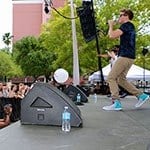Full Sail Stories
Published Jun 17, 2014
Game Studies Program Director Develops Oculus Rift Paragliding Simulator
Rob Catto has toured the Virtual Foot Flyer around to science museums, air shows, and technology centers.

Virtual reality has been a buzzword since the early 90s, but despite becoming an important tool in niche simulation industries, it never quite turned into the mainstream entertainment sensation that many had hoped. Twenty years later this technology is picking up momentum again thanks to devices like the Oculus Rift – a Kickstarter-funded virtual reality headset that is offering developers the kind of immersion the medium always promised at an attractive price point.
Among those hailing the device is Rob Catto, program director for Game Studies. Rob joined Full Sail in the early 1990s to teach the first course on virtual reality technology, and was an early backer of the Oculus Rift campaign. After seeing the headset’s specifications, especially the resolution and integration with game engines like Unreal and Unity, he started thinking of different application possibilities.
“I love virtual reality and when I heard about the helmet I realized that it would help me do some of the things that I had always wanted to do,” he says. “Hang gliding was actually one of the things I always wanted to simulate when we first had a VR class here at Full Sail, and I expanded on that with the idea of powered paragliding, which is another hobby of mine. Once I got that idea I immediately started working on a prototype and drawing together a plan on how to actually do this.”

Game Studies program director Rob Catto (left)
Powered paragliding is like a cross between parachuting and flying – where you’re secured in a harness with a propeller on your back, and suspended in the air by a cloth wing, similar to a parachute. The engine propels you forward while the wing keeps you aloft; a series of hand controls govern your throttle and steering. It’s a complicated setup to imagine trying to recreate, but Rob took off to his garage and broke down the paragliding experience into its core components. He’d eventually build a metal frame out of an old pull-up bar, secure a harness to it, then develop analog flight controls and simulation software.
“Actually putting somebody in a suspended harness was the first step in making it viable, then I tried to build on the immersion by involving as many senses as possible,” he says. “I started looking into what I could use to make the brake handles and throttle work the way they should, then I added a fan to simulate airflow, a bass speaker on the back to recreate the feeling of the propeller, and got the right sounds. From there it was a process of fine tuning the flight dynamics until it all felt right.”
The result is the Virtual Foot Flyer, a flight simulation unlike any other you’ve probably seen. After strapping into the machine and adjusting the Oculus Rift, the headset comes to life by surrounding your field of vision with a high definition 3D landscape, with you looking down on it from the air.
It doesn’t take long to forget that you’re still firmly on the ground. Turn your head left and the smooth frame rate flows naturally as you look around at the cars and building and trees below. Jamming your thumb on the throttle increases the rumble of the engine and the air blowing in your face, adding to the sense of speed. It’s an impressive experience, one that even paragliding enthusiasts have said recreates the feel and thrill of a real flight.
“The response I’ve gotten is humbling,” Rob says. “It’s an incredible feeling seeing people experience flight, because it’s as close to the real thing as you can get without going in the air. So many people have had positive things to say about it, and are clamoring at me to get one. With the next Oculus development kit coming out soon, it’ll only be able to be more immersive and appealing.”
Rob has toured the Virtual Foot Flyer around to science museums, air shows, and technology centers, and is currently working on a second model that iterates on a vision he was able to realize thanks to this new technology. Game industry veterans like John Carmack and Michael Abrash have been similarly inspired, joining the Oculus Rift team, while Sony is also working their own virtual reality headset for gaming – Project Morpheus.
As Rob explains, this is an exciting time not only for developers, but also for those currently studying computer science and game programming. New technology means new career paths as virtual reality research and implementation continues to grow across different fields. The affordability of these headsets also opens up the long-gestating possibilities of getting virtual reality into the hands of average consumers.
“Simulation is becoming a bigger part of almost any industry,” he says. “There’s urban simulation, military, medical, flight, disaster relief, and then gaming and other entertainment. It’s on the cusp of the whole ‘holodeck’ scenario you saw in Star Trek. The optics are going to get better – your field of view is going to be larger, and frame rates and the resolution will be better.”
“There’s really nothing else like it, and you can see that reaction when someone first tries it – once people put the helmet on and look around a big smile comes across their face. I can only think of the other possibilities for virtual reality.”



